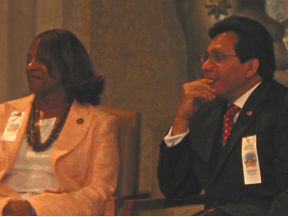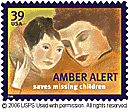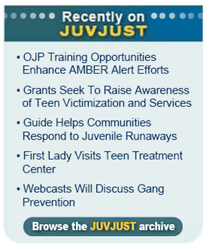
Printer-Friendly Version (May/June 2006) OJJDP and COPS Sponsor Gang Prevention WebcastsThe Office of Juvenile Justice and Delinquency Prevention (OJJDP), in partnership with the Office of Community Oriented Policing Services (COPS), hosted a two-part webcast and satellite broadcast titled "Preventing Gangs in Our Communities." The webcasts, which were originally broadcast live on May 23 and June 6, are available for online viewing at www.DOJconnect.com. Each webcast features a panel of gang specialists from federal and local law enforcement agencies and community and faith-based organizations. Discussion focuses on what law enforcement and communities are doing to share gang-prevention responsibilities. The webcasts should be of particular interest to law enforcement professionals; community and faith-based groups; state, tribal and local government executives; criminal justice professionals and educators; and other youth-serving professionals. A Justice Department Priority "Every American deserves to live free from the fear of violent crime. One way we are achieving this goal is through Project Safe Neighborhoods."
—Attorney General Alberto R. Gonzales
Gangs have become an increasingly dangerous threat to the safety and security of our nation's communities. On February 15, 2006, Attorney General Alberto R. Gonzales unveiled his plan to combat gang violence across America. The Attorney General's strategy is twofold: First, prioritize prevention programs to provide America's youth and offenders returning to the community with opportunities that help them resist gang involvement; and second, ensure robust enforcement policies when gang-related violence does occur. The Attorney General's Anti-Gang initiative will build on the effective partnerships and strategies developed through the Project Safe Neighborhoods (PSN) program by dedicating approximately $30 million in grant funding to support PSN anti-gang enforcement and prevention efforts and to provide training and technical assistance. "Gun crime and gang violence are shattering communities across the Nation," said Attorney General Alberto R. Gonzales at the PSN National Conference in Denver, CO, on May 2. "The Justice Department and our partners in the Project Safe Neighborhoods program are committed to preventing illegal gun crime and prosecuting violent offenders who break our laws and harm our citizens." In addition, the department will establish comprehensive anti-gang initiatives in six locations: Los Angeles, CA; Tampa, FL; Cleveland, OH; Dallas/Fort Worth, TX; Milwaukee, WI; and the "222 Corridor" that stretches from Easton to Lancaster, PA, near Philadelphia. The department is committing approximately $2.5 million in grant funding to prevention, enforcement, and offender reentry initiatives in each of these areas. Finally, since combating gang violence can only be done by working in partnership with state and local law enforcement and community organizations, the Attorney General directed each U.S. Attorney to convene a Gang Prevention Summit in his or her district designed to explore additional opportunities in the area of gang prevention. These summits are to be held in the next 8 months and will bring together law enforcement and community leaders to discuss best practices, identify gaps in services, and create a prevention plan to target at-risk youth within their individual communities. OJJDP's Gang Prevention Initiatives OJJDP's efforts to address the problem of gangs in the nation's communities include the Gang Reduction Program. The program is designed to reduce gang activity in targeted neighborhoods by incorporating a broad spectrum of research-based interventions to address the range of personal, family, and community factors that contribute to juvenile delinquency and gang activity. The program integrates local, state, and federal resources to incorporate state-of-the-art practices in prevention, intervention, and suppression. The online Community Guide to Helping America's Youth can be used to assist in developing comprehensive approaches to addressing gangs and other youth issues. In addition, OJJDP supports the National Youth Gang Center, which provides information, resources, and tools to help policymakers, practitioners, and researchers develop and implement effective, community-based gang prevention, intervention, and suppression strategies. To help reduce youth involvement in gangs and gang-related crime, the Center provides training, technical assistance, information on promising programs, and other resources. The Center also conducts annual surveys of youth gang activity. For answers to frequently asked questions about youth gangs, visit the National Youth Gang Center's Web site at http://www.iir.com/nygc/. Under the leadership of First Lady Laura Bush, Helping America's Youth—the HAY Initiative—is encouraging new partnerships and creative solutions to address the needs of children and teens. The initiative supports the basic principles of positive youth development and emphasizes the roles of families, schools, and communities in helping children avoid risky behavior and lead more hopeful lives. In the year ahead, Mrs. Bush will build on the success of the October 2005 White House Conference on Helping America's Youth by working with state and local partners to host regional conferences throughout the United States. The goal of these regional conferences is to increase public awareness and encourage adults to connect with youth in their communities. The first regional conference took place June 5-6 in Indianapolis, IN. President Bush announced the initiative in his 2005 State of the Union Address, calling for "a broader outreach to at-risk youth, which involves parents and pastors, coaches and community leaders, in programs ranging from literacy to sports." In October 2005, Mrs. Bush convened the White House Conference on Helping America's Youth, which brought together more than 500 parents, civic leaders, faith-based and community service providers, educators, child development experts, and others to discuss the challenges facing America's youth and ways to address those challenges. As part of the HAY Initiative, nine federal agencies collaborated to develop the Community Guide to Helping America's Youth, an online tool that communities can use to build partnerships, assess needs and resources, and access replicable program designs. The Guide includes:
Learn more about Helping America's Youth and access the Community Guide at www.helpingamericasyouth.gov.
The U.S. Department of Justice held its 23rd annual commemoration of National Missing Children's Day on May 25, 2006, at the Department's Hall of Justice in Washington, DC. The theme of this year's observance was "Bringing Our Missing Children Home Safely." Attorney General Alberto R. Gonzales and Assistant Attorney General for the Office of Justice Programs Regina B. Schofield presided at the event. The annual commemoration recognizes law enforcement personnel and private citizens for outstanding efforts on behalf of missing and exploited children. Attorney General Alberto R. Gonzales gave the keynote address and Postmaster General John E. Potter announced the official issuance of the AMBER Alert Awareness stamp (see related story). This year, the Attorney General's Special Commendation went to Officer Flint Waters of Wyoming's Internet Crimes Against Children (ICAC) Task Force for his devotion to protecting children and his many contributions to the ICAC national program. Twelve other officers received awards for their efforts in recovering missing children and combating child exploitation.
Assistant Attorney General Schofield, who is the National AMBER Alert Coordinator, presented the AMBER Alert Citizen Award to Agatino Amoroso of Cooper City, FL, and Chastity Angell and Mike Butcher of Ivins City, UT. John Bish of Warren, MA, whose 16-year-old daughter Molly was kidnapped and murdered in 2000, also addressed the audience. Assistant Attorney General Schofield presented Courage Awards to two youngsters in recognition of their bravery during abductions. Families of missing children were among the guests at the ceremony. Also participating in the commemoration was Ernie Allen, President of the National Center for Missing and Exploited Children (NCMEC), who presented the NCMEC Volunteer of the Year Award to Khaliah Ali, Newtown Square, PA, and the NCMEC Law Enforcement Leadership Award to Special Agent Flint Waters. Catherine Braun, a student at Our Lady of the Snows School, Eugene, MO, accepted the 2006 National Missing Children's Day Art Contest Award. The ceremony closed with songs from the Orr Elementary School Chorus, Washington DC, and Magi Bish, who sang "I Looked for You," a song she wrote in honor of her daughter Molly.
National Missing Children Awards, 2006 Special Agent James T. Minor, U.S. Department of State, Bureau of Diplomatic Security, Bangkok, Thailand, recovered a 6-year-old boy whose noncustodial parent abducted him in Texas and fled to Thailand. As a result of Special Agent Minor's actions, the boy was successfully reunited with his father in 11 days. Lieutenant John R. Arndell, Lyon County Sheriff's Office, Silver Springs, NV, and Special Agent John A. Ginocchio, Federal Bureau of Investigation (FBI), Reno, NV, rescued an 8-year-old girl who was abducted by a registered sex offender and transported to Mexico. Lieutenant Arndell and Special Agent Ginocchio coordinated the successful recovery of the child, whose kidnapper was sentenced to 17 years in a Mexican federal prison. Sergeant Michael Hall, Lake Worth Police Department, Lake Worth, FL, rescued an 8-year-old girl who nearly died at the hands of her teenage assailant. The assailant had falsely reported the girl as missing. National Exploited Children's Awards Detective Kevin Wiens, Fresno County Sheriff's Department, and Special Agent Mike Prado, U.S. Immigration and Customs Enforcement, both of Fresno, CA, acting on a tip from the NCMEC CyberTipline, arrested a youth softball program coach who was trading images of child pornography via e-mail and who also admitted to molesting a 12-year-old girl whom he had coached. Detective Wiens and Special Agent Prado then traveled to Pennsylvania, where they arrested the main purveyor of the pornography they found in Fresno and also uncovered a network of child pornography distributors. Sergeant Chris Hunt, Indiana State Police, and Special Agent J. Tom Rothrock, U.S. Immigration and Customs Enforcement, both of Indianapolis, IN, working with information from the NCMEC Child Victim Identification Program, located a child who had been sexually abused in an Internet video and then tracked down her abuser, a convicted sex offender in possession of child pornography, including images of at least four children he had molested. The man is currently in custody facing life in prison. In the "Precious Cargo" investigation, the teamwork of four officers—Trooper David E. Olweiler, Pennsylvania State Police, and Special Agent Christopher D. Kegerreis, Internal Revenue Service, both of Harrisburg, PA; FBI Special Agent Mike Beaver, Oklahoma City, OK; and FBI Intelligence Analyst Jamie L. Konstas, Washington, DC—led to a 33-count federal indictment against 16 individuals involved in child prostitution.
"Our children are our most precious asset. AMBER Alert enables every citizen to aid in ensuring that abducted children are brought home safe and sound."
—J. Robert Flores, OJJDP Administrator
OJJDP Administrator J. Robert Flores joined representatives from the U.S. Postal Service in a First Day of Issue Ceremony for the new AMBER Alert stamp. The ceremony, held on May 25 in honor of Missing Children's Day (see related story), took place in Arlington, Texas, home of Amber Hagerman, whose tragic 1996 abduction and murder inspired the creation of the program that bears her name.
Tarrant County Sheriff Dee Anderson, a leading investigator during the Amber Hagerman investigation and co-founder of the AMBER Alert, detailed the local history of AMBER Alert. He was followed by Donna Norris, Amber's mother, who thanked the network of people throughout the nation who have participated in the AMBER Alert effort to safeguard the lives of so many children. Administrator Flores concluded the ceremony by acknowledging the significant accomplishments of the AMBER Alert plan. In February 2005, Hawaii became the 50th state to complete its statewide AMBER Alert plan, creating a network of plans nationwide. Twenty-seven regional and 37 local plans also have been established. As of May 2006, more than 260 abducted children have been recovered as a result of the AMBER Alert program. Mr. Flores commended the strong support of law enforcement professionals across the country who generously give of their time and efforts to the AMBER Alert program. He also emphasized the Department of Justice's strong commitment to keeping the nation's children safe. For more information, visit the Office of Justice Programs' AMBER Alert Web site: www.amberalert.gov.
The National Network of Youth Ministries (NNYM), with support from the Office of Juvenile Justice and Delinquency Prevention, recently released a Mentor Recruitment Kit. The free kit includes a DVD, a step-by-step recruitment strategy booklet, and a poster. It can be ordered online at MentorYouth.com, NNYM's mentoring Web site. MentorYouth.com's purpose is "to enlist, encourage, equip, and empower adults in the church and the community to become mentors to young people." The site provides a variety of resources, including a registry of mentoring programs, a community message board, mentoring success stories, and an "ask an expert" feature. MENTOR: The National Mentoring Partnership.
Training opportunities sponsored by OJJDP during July–August 2006 are outlined below. For details, visit the OJJDP Web site at www.ojp.usdoj.gov/ojjdp and click on "Events."
July 17–21
July 24–28
August 7–11
August 14–18
All OJJDP publications may be viewed and downloaded at ojjdp.ncjrs.gov/publications. Print publications may also be ordered from the Juvenile Justice Clearinghouse (order online or call 800-851-3420).
Now Available Coming Soon OJJDP's NISMART Bulletin series presents findings from the Second National Incidence Studies of Missing, Abducted, Runaway, and Thrownaway Children (NISMART–2). These publications offer national estimates of missing children based on surveys of households, juvenile residential facilities, and law enforcement agencies. They also provide statistical profiles of these children, including their demographic characteristics and the circumstances of their disappearance.
The next Bulletin in the NISMART series, currently in production, will draw on NISMART–2 data to present a special analysis of sexually assaulted children. Sexually Assaulted Children: National Estimates and Characteristics will estimate the number of children assaulted nationwide and describe the characteristics of victims, perpetrators, and incidents. The Bulletin will also explore methodological issues in estimating the incidence and nature of child sexual assaults.
JUVJUST Listserv OJJDP's JUVJUST listserv provides e-mail notices of the latest juvenile justice and other youth service related news. Every week, JUVJUST subscribers receive announcements of publications, funding opportunities, conferences, and other valuable resources. JUVJUST postings are "hot off the press"—the perfect complement to the bimonthly News @ a Glance, which covers similar topics—plus recent OJJDP activities—in greater depth. JUVJUST is a free information service available to anyone with Internet e-mail. Subscribe now and join thousands of your colleagues who already receive JUVJUST and News @ a Glance.
The following is a brief summary of OJJDP's recent funding activities. Be sure to check the Current Funding section of the OJJDP Web site for the latest news on OJJDP funding opportunities. To receive e-mail notification of new funding opportunities, subscribe to JUVJUST. Upcoming Solicitations OJJDP is expecting to release the following solicitations in summer 2006. Please check the OJJDP Web site for more information, as it becomes available. OJJDP State Advisory Group Training Grant. The recipient of this 1-year cooperative agreement will provide training to the nation's State Advisory Groups (SAGs). The goal of this cooperative agreement is to facilitate the design and delivery of high-quality, innovative OJJDP-supported training to all SAG members. Public agencies (including state agencies, units of local government, public universities and colleges, and tribal governments) and/or private organizations (including secular and faith-based nonprofit organizations) are eligible to apply for this cooperative agreement. Private for-profit organizations must agree to waive any profit or fees. Evaluation of Juvenile Drug Courts. This grant will support an independent evaluation of the strategies employed in juvenile drug courts and their impact on the behavior of participating youth. The evaluation's findings will contribute to a more comprehensive assessment of juvenile drug courts and their role in assisting substance-abusing youth involved in the juvenile justice system. Public agencies (including state agencies, units of local government, public universities and colleges, and tribal governments) and/or private organizations (including secular and faith-based nonprofit organizations) are eligible to apply. Joint applications from two or more eligible applicants are welcome; however, one applicant must be clearly indicated as the primary applicant (for correspondence, award, and management purposes) and the others indicated as co-applicants. News From the Coordinating Council on Juvenile Justice and Delinquency Prevention The Coordinating Council on Juvenile Justice and Delinquency Prevention is an independent body within the executive branch of the federal government. The Council's primary functions are to coordinate federal juvenile delinquency prevention programs, federal programs and activities that detain or care for unaccompanied juveniles, and federal programs relating to missing and exploited children. The Council's most recent meeting, hosted by the U.S. Department of Health and Human Services, was held June 2, 2006, at HHS's Humphrey Building. The meeting featured opening remarks from HHS Secretary Mike Leavitt; a presentation on Child and Family Service Reviews by Susan Orr, Associate Commissioner, Children's Bureau, HHS; and a discussion of mentoring with Harry Wilson, Associate Commissioner, Family and Youth Services Bureau, HHS, Theresa Clower, Senior Policy Advisor and Executive Director, Mentoring Council, Corporation for National and Community Service, and Mason Bishop, Deputy Assistant Secretary, Employment and Training Administration, U.S. Department of Labor. OJJDP Administrator J. Robert Flores provided closing remarks and announcements. The next Council meeting is scheduled for September 8, 2006. For meeting summaries, information about the Council's mission, and links to related resources, visit the Council's Web site at juvenilecouncil.gov.
The Federal Advisory Committee on Juvenile Justice is a consultative body established by the Juvenile Justice and Delinquency Prevention Act of 2002 and supported by OJJDP. Composed of representatives nominated by the Governors, the Committee advises the President and Congress on matters related to juvenile justice, evaluates the progress and accomplishments of juvenile justice activities and projects, and advises the OJJDP Administrator on the work of OJJDP. The Advisory Committee's most recent meeting was held on May 8–9, 2006 in Washington, DC. Highlights of the meeting included remarks by J. Robert Flores, OJJDP Administrator, and David Schmidt, Chair, Federal Advisory Committee of Juvenile Justice. Open sessions included a presentation on Adolescent Brain Development delivered by Diana H. Fishbein, Director, Transdisciplinary Behavioral Science Program, Research Triangle Park International, MD; and a presentation on Mental Health Blueprint for Change delivered by Dr. Joe Cocozza, Director, and Kathy Skowyra, Consultant, National Center for Mental Health and Juvenile Justice, NY. Discussions followed each of the presentations. Closed sessions included working meetings of the Annual Report, Planning, Legal, and Grants subcommittees. Meeting summaries and other information about the Advisory Committee are available on the Committee's Web site.
May marked the retirements of two of OJJDP's most longstanding and respected staff members. Barbara Allen-Hagen retired after more than 30 years of distinguished federal service. During her tenure at OJJDP, Barbara was instrumental in the development of several groundbreaking juvenile justice programs, including the award-winning Performance-based Standards (PbS) for Youth Correction and Detention Facilities (see story in the September/October 2004 issue of News @ a Glance). Barbara was also responsible for overseeing numerous national programs and studies, including the Juvenile Justice Statistics and Systems Development Program, which produced the landmark National Reports on Juvenile Offenders and Victims and the first national study of Conditions of Confinement for youth. Through her work on projects such as the National Incidence Studies of Missing and Exploited Children (NISMART 1 and 2), the Study Group on Very Young Offenders, the Study Group on Serious and Violent Offenders, and the Girls Study Group, Barbara has played a major role in the significant gains in knowledge regarding the causes and prevention of juvenile delinquency and our understanding of the issue of missing children in the past three decades.
Peter Frievalds joined OJJDP in 1976, after spending several years working for the State of Maryland, where he helped to oversee the state's law enforcement training programs and worked in the juvenile justice system. One could almost say that Peter served at OJJDP before the Office even existed. Previous to his service in Maryland, Peter staffed the U.S. Senate's Juvenile Justice Advisory Committee, the group that recommended the creation of OJJDP in the early 1970s. At OJJDP, Peter was a proponent of the Balanced and Restorative Justice (BARJ) Program and advocated for its adoption throughout the juvenile justice system. BARJ underscores the importance of the victim (individual or community) in the justice process and requires the offender to actively pursue restoration of the victim by paying restitution, performing community service, or both. |
|||||||||||||||||
OJJDP Home | About
OJJDP | E-News | Topics | Funding | Programs
State Contacts | Publications | Statistics | Events |




 Susan Plonkey, Vice President of Customer Service for the U.S. Postal Service was the dedicating official and unveiled the new commemorative stamp. The goal of the 39-cent stamp, which features an illustration of a reunited mother and child, is to educate the American public and help to heighten public awareness of the AMBER Alert program.
Susan Plonkey, Vice President of Customer Service for the U.S. Postal Service was the dedicating official and unveiled the new commemorative stamp. The goal of the 39-cent stamp, which features an illustration of a reunited mother and child, is to educate the American public and help to heighten public awareness of the AMBER Alert program.
